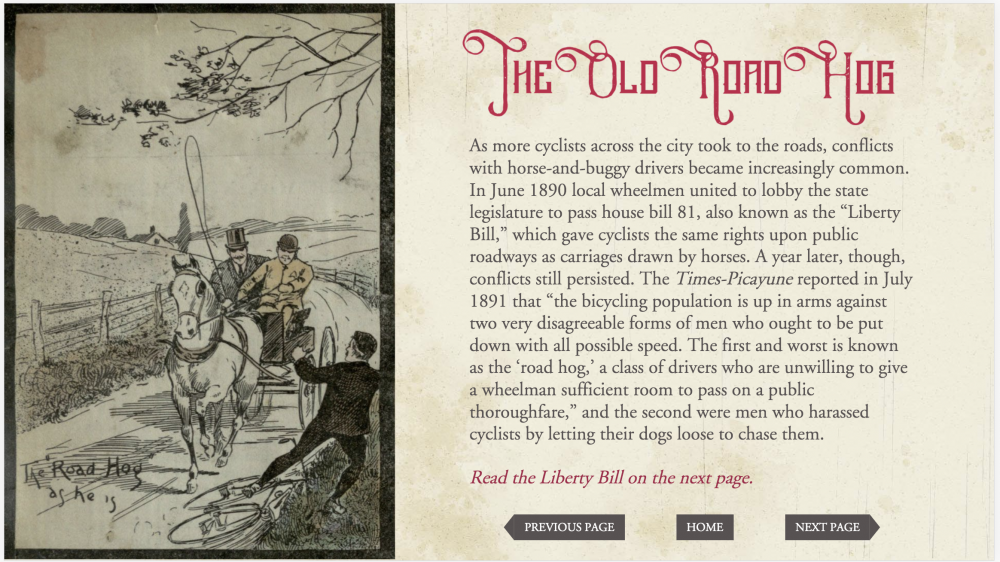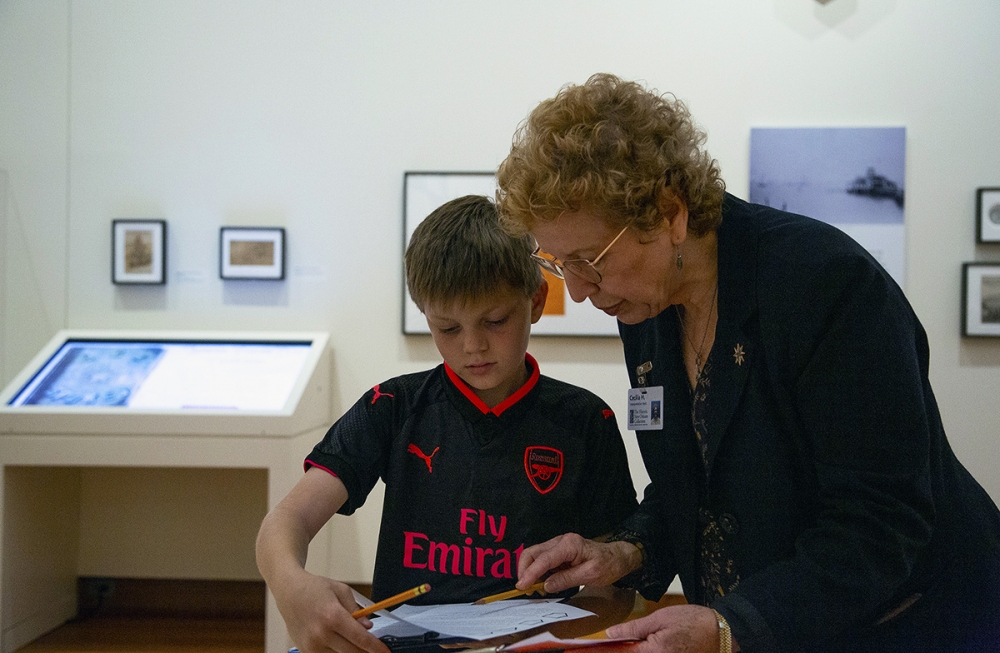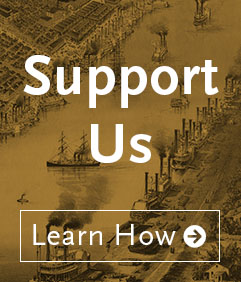What a year at The Historic New Orleans Collection! Our staff has toiled for the past twelve months with opening a brand-new campus, producing several major exhibitions, finalizing new original publications, all while making 471 acquisitions of historical materials (at the time of publication) for our ever-expanding archive.
We also look back fondly on our former President/CEO Priscilla Lawrence’s 39 years of service to the institution, while charging into a new era with our new leader, Daniel Hammer.
There’s so much to talk about for this year’s edition of our favorite moments (see the 2018 edition, our first ever, for more) that we will just get to it. So here are a dozen times that our staff was moved by their work in this banner year.
1. The Empty Window

The Empty Window by Michael Deas was featured in the exhibition Art of the City: Postmodern to Post-Katrina, presented by The Helis Foundation. It was the inaugural special exhibition in THNOC's new facility, which opened in April 2019. (Artwork courtesy of Michael Wilkinson)
Playing the If-you-could-display-one-of-these-artworks-in-your-home-which-would-you-choose game with other staff members in the Art of the City exhibition during an after-hours event, I chose Michael Deas’s The Empty Window, a photorealistic painting of a cloudscape over the French Quarter. The painting glowed, as if there were a light behind it, somehow simultaneously ominous and calming. As the evening drew to a close and visitors were being ushered out, one couple rushed in and pleaded to be allowed upstairs, to see one particular artwork. I offered to escort them. In the elevator, I asked what they wanted to see: I was delighted when they said The Empty Window, and more so when the man introduced himself as the artist. Deas told me about the glazes he used to create the glowing effect and the years-long process of creating this painting of a single captured moment. The coincidence felt like a gift from the universe, as if my enjoyment of the painting had put me in exactly the right place to learn about its creation.
—Margit Longbrake, senior editor
2. Show-stopping posters

Emily Perkins holds a poster for a 1970 Grateful Dead show that was featured in 64 Parishes. (Photograph by Eli A. Haddow)
I cataloged a collection of performing arts ephemera that contained almost 400 posters for plays, dance performances, concerts, art exhibitions, and other cultural events in the Crescent City, primarily from the 1960s to the 1980s. The posters, which were probably hung from light poles and stuck to bulletin boards around town, offer great insights into New Orleans nightlife and local culture during the late 20th century. The theater scene looks like it was particularly active, with risqué live plays and new venues popping up almost monthly—and disappearing just as fast. The collection is a great resource for researching these little-known venues and performances, and has been frequently requested in our reading room since it’s been made available. Recently one of the posters was reproduced in 64 Parishes, where there was an article about the January 1970 Grateful Dead concert on Tchoupitoulas Street that inspired the “Truckin’” lyrics, “Busted, down on Bourbon Street.” It’s exciting to see the work that I do reflected in local journalism so quickly.
—Emily Perkins, curatorial cataloger
3. Birds on parade

The Oakley Plantation house near St. Francisville, Louisiana is home to Indigo, one of the more exotic "pets" on this year's Classical Institute of the South field study. (Images courtesy of Sarah Duggan)
In my travels cataloging decorative arts for the Classical Institute of the South project, there is often a friendly dog or cat at the field work site who quickly becomes a mascot of sorts. In social media parlance, we call these furry friends the #PetsofCIS. This year’s CIS summer fellows and I had a unique #PetsofCIS installment: a peacock named Indigo. We met him while cataloging artifacts at Oakley Plantation house at the Audubon State Historic Site near St. Francisville. This beautifully shaded Louisiana state park preserves the area where naturalist John James Audubon spent the summer of 1821 at Oakley, working as a tutor for young Eliza Pirrie. The fellows and I would hear Indigo’s “Caw-AW!” cries coming from a different direction every day. We never knew where we’d find him strutting around! Our delight every time he sauntered past gave us a taste of the excitement and curiosity Audubon must have felt exploring that same ground 200 years before.
—Sarah Duggan, CIS Coordinator and Research Curator
4. The emperor’s new legs

Lindsay Rowinski holds the mannequin of Ernie K-Doe. She worked to restore the figure's legs so that he could sit in Art of the City. (Image courtesy of Lindsay Rowinski).
I had an intimate encounter with the handmade effigy of Ernie K-Doe—the self-styled “Emperor of the Universe”—last winter when I was assigned the task of refurbishing his legs for the Art of the City exhibit. After Ernie passed in 2001, local artist Jason Poirier captured the late K-Doe’s likeness by using parts of a storefront mannequin. Because the original mannequin was standing, Poirier had to improvise in order to get him to sit. The original “bones” were fabricated from two-by-four boards, the “muscles” from newspapers that had deteriorated into confetti, the “skin” made from towels topped with ripped pantyhose and duct tape, and the feet, belonging to the original mannequin, were screwed into the bottom of each leg. While these materials served as a fantastic low-cost solution to creating the likeness of K-Doe in a pinch, they were no match for 18 years of travel around the city with his widow, Antoinette, and holding court at the Mother-in-Law Lounge day in and day out. It is strange to find oneself feeling such an affinity to an inanimate object, especially one as uncanny as the K-Doe statue, but I now feel like Ernie and I share a special bond. I feel what I assume Poirier felt when he first resurrected Ernie’s visage: that by giving him new legs, I was able to give him new life.
—Lindsay Rowinski, assistant preparator
5. Copyedited critters

Marjorie Clarke's illustrations made for whimsical advertisements in the 1930s through '60s. (THNOC, gift of Dr. Edward B. Ferguson Jr., 1999.50.7 i-v)
Cozy critters may not be the first thing that comes to mind when one thinks of department store glamour in the mid-20th century, but Marjorie Clarke’s advertisement illustrations made a whimsical splash in New Orleans’s iconic Kreeger's and Godchaux's department stores and newspaper advertisements. This year, I had the pleasure of processing a fabulous collection of Clarke’s sketches, completed during the 1930s though ’50s. As a commercial illustrator during this period, Clarke was in a minority of women working in this male-dominated industry. Her work reflects the vibrancy and playfulness of the city of New Orleans, and I enjoyed having the opportunity to care for her art. When you’re a registrar, you never know what’ll end up at your desk—fine coats and little camels included!
—Kelley Hines, registrar
6. Bicycle race!
 Candy Ellison was responsible for designing an interactive take on a bicycle club's scrapbook for the exhibition Crescent City Sport.
Candy Ellison was responsible for designing an interactive take on a bicycle club's scrapbook for the exhibition Crescent City Sport.
Among the historic objects situated in THNOC’s Crescent City Sport exhibition, a large touchscreen experience is bound to stand out. This interactive installation takes visitors into the pages of the Louisiana Cycling Club’s Victorian-era scrapbook, an artifact bursting with humor and personality. Much of the content is relatable to those of us in New Orleans who spend time on bicycles—such as the tongue-in-cheek portrayal of the “road hog,” who rudely pushes a penny-farthing rider off the road with his inconsiderate horse-and-buggy driving.
Creating the interactive scrapbook provided an amazing opportunity for me to collaborate with curators and editors, and the artifact was a goldmine of material I could use to create something that could not only educate, but also delight visitors—from the interactive animations to the Victorian typefaces. One of the more challenging (and rewarding) pieces of the installation was a penny-farthing race that we created on a touch screen that mimics an 1890 Thanksgiving race from Claiborne Avenue to West End. The penny-farthings, and the other animations peppered throughout, were created from images in the original scrapbook, and brought to life through animation.
—Candy Ellison, interface/interactive designer
7. Reaction to the JFK assassination
Raw video footage captues reactions to John F. Kennedy's assassination on November 22, 1963. (THNOC, ©Don Perry and associates, gift of Paul Werner, 2016.0142.40)
There’s a lot of old news footage out there from the day that John F. Kennedy was shot in his Dallas motorcade, but I came across something that I never thought I would see: reactions from New Orleans on November 22, 1963. Sure enough, minutes after the shots were fired, a local reporter went down to Canal Street to get some man-on-the-street interviews. Many people had not yet heard the news, and others were simply speechless. Their raw words, expressions, and emotions, unedited and uninterrupted, jolted me right into their world in a way that polished films of that era cannot. The scene itself also left an impression. The bustle of Canal Street, the clothing of the interview subjects, and even the signage for stores I knew to be long gone came back to life in this extraordinary video.
—Eli A. Haddow, marketing associate
8. Ulloa's morocco-bound book

The red morocco cover of Antonio de Ulloa's Notician Americanas bears the coat of arms of King Charles III of Spain. (THNOC, 2019.0132)
Although Antonio de Ulloa has long been dismissed as the Spanish governor of Louisiana ousted by French inhabitants of New Orleans, I gained a new appreciation of his historical contributions through a book published in 1772. This year THNOC acquired an exquisitely bound copy of Ulloa’s Noticias Americanas, which presents his scientific studies concerning climate, natural history, geography, geology, and ethnography. This first edition was presented to King Charles III of Spain, and the red morocco cover bears the monarch’s coat of arms. Of particular interest to me were his weather observations, noting that New Orleans was cooler in the winter and yet warmer in the summer than Havana, dispelling the prevailing thought at the time that distance from the equator was the only factor directly affecting temperature. Louisiana indigenous peoples also engaged in detailed body painting, which Ulloa commented upon.
—Pamela D. Arceneaux, head librarian/rare books curator
9. Engaging the youth

Cecilia Hock works with Henry Jahnke in the galleries of Crescent City Sport. (Photograph by Melissa Carrier)
Audience engagement is an essential aspect of THNOC’s value to the community, so members of the Visitor Services department invited a group of employees’ children to evaluate the youth activity worksheet for young visitors to our newest exhibition, Crescent City Sport. The team of testers arrived early one Saturday morning to interact with the exhibit and later participated in a focus group that provided us with valuable input. Their effort will help to create a more meaningful experience for all of our young visitors. Their overall assessment: “That was fun!”
—Cecilia Hock, interpretation assistant
10. A relic related to Sacred Heart

Looking through a manuscripts collection, Michael Redmann happened upon this relic from St. Madeleine Sophie Barat. (THNOC, the William Devlin Papers, 84-119-L)
I noticed a relic of St. Madeleine Sophie Barat, the founder of the religious sisters of the Society of the Sacred Heart, in the William Devlin Papers. The relic is interesting because it was probably collected by Devlin on a trip to Rome in 1879, when Barat had only just been declared venerable, a step on the way to canonization and sainthood. The second-class relic—meaning something that the saint wore or used—is a small piece of cloth from Barat’s clothes. It is attached to a card with identifying information and prayers. The presence of Barat’s order of sisters in New Orleans—most notably the Academy of the Sacred Heart—may have influenced Devlin’s devotional interest. Barat was beatified in 1908 and canonized in 1925.
—Michael M. Redmann, manuscripts cataloger
11. Upstaging Hamilton

Hamilton played at the Saenger Theatre in March of 2019. Rebecca Smith was there when students put on their own historical performances. (Photograph by Eli A. Haddow)
One of the highlights of my year was getting to chaperone Hamilton at the Saenger Theater in March. The Gilder Lehrman Institute of American History partners with the producers of Hamilton to provide inexpensive tickets to the musical to underserved students. The New Orleans run of the show included a matinee performance for about 4,000 high schoolers from across Louisiana and Mississippi, and THNOC was asked to provide a few volunteers to help chaperone and make sure the day ran smoothly. As a big fan of the show, I was thrilled to participate! Before the matinee about a dozen individual students and groups presented original poetry, songs, raps, humorous and serious readings based on historical events. The students were so talented and creative that they almost stole the show! It was inspiring to be a part of the audience for them, and I was incredibly grateful for the opportunity to attend.
—Rebecca Smith, head of reading services and interim head of processing
12. Art in the city

THNOC's Caillot Circle members enjoy the Portage Bike Roll with guide Cassady Cooper. (Photograph by Keely Merritt)
As part of this year’s landmark exhibition Art of the City: Postmodern to Post-Katrina, presented by The Helis Foundation, our staff was challenged to reach beyond the museum walls and find ways to bring our programming out into the city. We created such programs as an outdoor banner series, a children’s art education program at Café Reconcile, and free guided bike tours focused on public art along the historic portage route that connected the Mississippi to Lake Pontchartrain. I had the opportunity to work on some of these events, and it was so rewarding to see folks across the city enjoying our free educational programs.
—Amanda McFillen, programming manager













